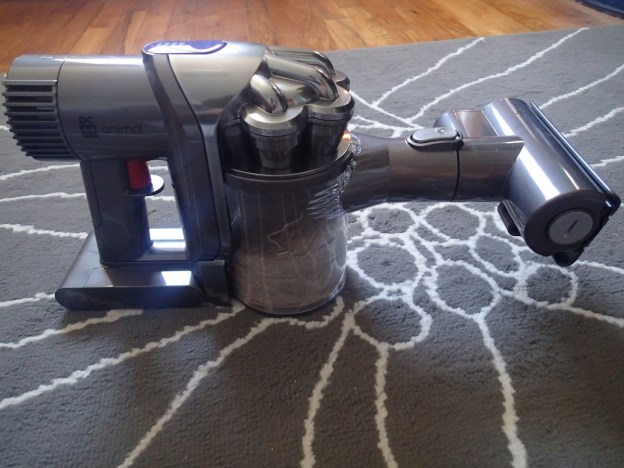
Dyson vacuums have long been one of the pioneers in its own industry, offering an array of high-end equipments that are stylish, functional, and incredibly expensive. As gadget enthusiasts, we could not help but be excited by the latest Dyson Animal Digital Slim model, the DC44, which is portable, wireless, and gets the job done in no time. But at a retail value of $400, it’s admittedly not the most ideal price point for the average family. Here’s a look at what the shiny new gadget offers that most vacuums on the market do not.
Look and feel

Straight out of the box, the DC44 requires minimal assembly. All you need to do is pick your intended attachment, which ranges from an extended leg for floor work, short cleaner head, crevice tool, and a combination tool that has a large opening and brush. The device comes charged, but if not, each charge takes 1-2 hours and will last you about 15 to 20 minutes. That seems short, but you can clean a decent amount in that time thanks to the power of this so-called Root Cyclone technology.
Utility

Starting with my carpet, I attached the regular cleaner head to the DC44 body and off it goes. The vacuum is loud, but not any louder than your average machine. One sweep of my carpet and you can see the dust beginning to pile inside the bin, and the DC44 is powerful enough that only one swipe is necessarily for a section. I’m so used to going over the same area several times and it became clear why 20 minutes worth of charge is reasonable for one cleaning session. If you need extreme suctioning for a certain trouble spot, you can switch to turbo mode, but it will drop the battery life down to approximately seven minutes. The vacuum will also work on wood floors, sofa covers, and car seats with the right attachment hooked up.

Some faults
One of my biggest gripes with the Dyson DC44 Animal Digital Slim is probably my own fault. Guys, this is TMI, but my hair just sheds too damn much. A five-minute vacuum of my carpet and the underside of the cleaner head revealed a tangled mess of hair stuck between the teeth of the brush and the motor roll. In the short run, this won’t mean much if I continually clean it off and yank the pieces out. However, if you forget to do this, or if you are cleaning a large chunk of pet hair, you might run into some trouble with tangled hair clogging up the opening of the vacuum. This could be fixed by using the larger crevice tool, but it just made more sense for me to use a regular cleaner head on my bedroom carpet so this tangle is a bit annoying.

Another issue is the size of the DC44. Yes, the device is made to be compact, but perhaps it’s … too small? After vacuuming for 10 minutes, I found that I have to empty the dust bin before vacuuming again to finish up cleaning my apartment. Or again, maybe my room is just super dirty and I do not vacuum often enough. This item is ideal for those living in small spaces, but homeowners who want a cordless, handheld vacuum cleaner to get the job done in the entire house may have to go for the larger, full-sized Dysons.
Bottom line
So we come back down to the big question: Is spending $400 on this vacuum justifiable? Aside from small issues here and there, the Dyson DC44 Animal Digital Slim is an absolutely superior choice than most handheld vacuums on the market, and would be perfect for small apartment owners. It gets the job done well and fast, and is worth an investment if you aim to use it repeatedly over the course of the next few years. The price tag is impractical for most families, but when you consider the cost of bag replacement, cordless flexibility, and the ability to multitask the vacuum to clean both your car and your home, you’ve got yourself an all-in-one tool that’s pretty much the Apple of the vacuum world, and it’ll be hard to find any other machine that’s nearly as capable as a Dyson.


